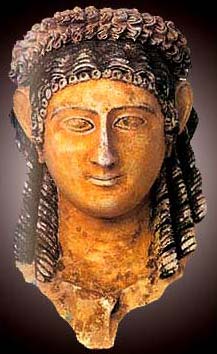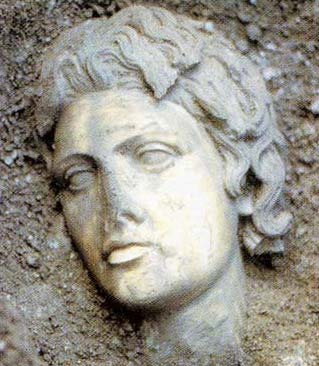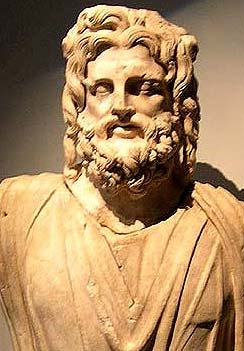Alexandria National Museum
As the principal anchorage of the Hellenic Empire,
the Ptolemaic capital and Egypt's second largest metropolis,
the Mediterranean port of Alexandria has always been a center
of cultural significance. Celebration of this has been a
big part of Alexandria's recent development, and these days
there is the Alexandria National Museum, a splendid facility
that documents Alex's rich heritage.
The Alexandria National Museum has grown in importance
these days, and is now considered one of Egypt's finest
museums. It was inaugurated by President Hosni Mubarak on
December 31st, 2003, and is one more addition to the reasons
one should visit this grand old city. The national museum
is located in a restored palace and contains about 1,800
artifacts that narrate the history of Alexandria throughout
the ages, including the Pharaonic, Roman, Coptic and Islamic
eras. There are even some more modern pieces, including
19th century glassware, silverware, chinaware and precious
jewels, which provide a sense of the richness of the court
of Mohammed Ali and his descendants. Mummies are shown in
a special underground chamber (basement). Also, some of
the items found during the archaeological underwater excavations
in Alexandria are now on the same floor as the Greco-Roman
artifacts.
 |
The museum is housed in the old Al-Saad Bassili
Pasha Palace. He was one of the wealthiest wood merchants
in Alexandria during his lifetime. It is located on Fouad
Street (Tariq al-Horreyya), near the center of the city.
Construction on the site was first undertaken in 1926. The
palace covers an area of 3,480 square meters,. It is a white
Italian-style mansion that sits in an expansive garden of
rare trees and plants. The palace consists of four floors
and an underground shelter, which was used during World
War II air raids. The palace was designed by a French engineer
who used the Italian styles in its construction. His three-store
palace was a gathering place for the upper class people
of Egyptian society in Alexandria, including notables such
as Egyptís former Prime Ministers, Ismail Sedqi Pasha and
Ali Maher Pasha, along with many others. This villa was
sold to the Americans as a consulate in 1960, and thereafter
in 1997, was purchased by the Ministry of Culture for about
12 million LE. Its conversion to a museum, including up
to date audiovisual equipment, security and fire protection,
cost another 18 million LE. In the preparation of the Alexandria
National Museum, the highest of standards has been adopted,
especially in display techniques and in the design of educational
and cultural galleries.
 |
The recent realization that Egypt's museums
were originally made not to assume an educational and cultural
role, but rather to function as buildings for storing antiquities
had led the Ministry of Culture to begin transforming them
into places which transmit to the visitor a cultural message
about the varied creative products of the Egyptian civilization.
The Alexandria National Museum is the first of its kind
in Egypt. It is the only one which narrates the history
of the people of Alexandria through antiquity.
Passing through the main gate, one mounts an elegant
semi-rounded staircase in view of a life-size Graeco-Roman
Period marble statue of a toga-clad matron. Crossing a small
but luxuriously decorated foyer with two rows of speckled
grey marble columns, one enters the museum proper.
Within, one willl find symbolic colors used, just
as they were during Pharaonic time, in a specific arrangement.
One will notice that the Pharaonic section itself features
dark blue walls. This color is meant to portray the journey
of the ancient Egyptians to their eternal afterlife. In
the Graeco-Roman Period section, objects are set against
a sky-blue (marble color) colored backdrop, reflecting romance
and a lust for life. As Copts and Muslims share beliefs
concerning heaven, the sections reserved for artifacts from
these religious traditions are painted green.
The artifacts within the museum's collection have
not been exhibited in the past. They were previously in
storage in various other Egyptian museums, and therefore
come from the Egyptian Antiquity Museum and the Coptic and
Islamic Museums in Cairo. Others are from the Graeco-Roman
and Jewelry museums in Alexandria, which are closed nowadays
for renovation.
Items from the Pharaonic Period span each critical
period, including the Old, Middle and New Kingdoms. Among
the masterpieces on display is a statue of King Menkaure,
the builder of the third pyramid at Giza, a head of a statue
of Akhenaton (Amenhotep IV) and a head of Hatshepsut, the
great female pharaoh of Egypt. There is also a fine statue
of a scribe and several statuettes of servants depicted
in the midst of daily activities. There are also a number
of offering tables, building tools and statues of deities.
In addition, there is a replica of a tomb, similar
to those in the Valley of the Kings on the West Bank at
Luxor (ancient Thebes), that contains one mummy along with
genuine funerary equipment. These items include canopic
jars, an anthropoid sarcophagi containing the mummy, ushabti
figures and the deceasedís private possessions. The tomb
is meant to provide an overview of the Ancient Egyptian
concept of burial and the afterlife.
Alexandria was a Graeco-Roman city of great splendor,
and there is no scarcity of objects from this period. Among
the most noteworthy are the beautifully painted terra-cotta
Tanagra figurines of fashionably dressed Greek women. The
figurines stand motionless with styled looks, wearing hats
or veils, and holding children, fans or pets.
From the Roman Period, displays include busts of
the Emperor Hadrian and a red granite statue of Caracala.
The collection also includes reports from pioneering scientific
studies on the human body undertaken in Alexandria, complete
with marble hands, legs and torsos.
A highlight of the museum is a display (on the
Graeco-Roman floor) of artifacts raised during underwater
excavations around Alexandria in recent years. To provide
a comprehensive look at this new branch of archaeology,
huge posters feature activities from various underwater
sites over the last few years. Here, one finds some of the
most important pieces raised from the sea bed, including
a black basalt statue of a high priest in a temple of the
goddess Isis, lifted in 1998, a 2.2 meter granite statue
of Isis found in May 2001. There is also the granite stela
of King Nakhtnebef, which is an identical copy of the Naucratis
stela, discovered in the sunken city of Heraklion offshore
from Abuqir.
 |
The floor devoted to Coptic and Islamic items has
a variety of objects from Egypt's two most prominent religious
traditions. Coptic Christian items include icons of Jesus
and the Virgin Mary and the Last Supper, as well as tombstones
and clothes decorated with golden and silver crosses. Among
the Islamic objects are a collection of 162 gold and silver
coins minted in Alexandria, a number of metal incense burners,
chandeliers, decorated pottery, doors and mashrabiya windows
inset with geometrical ivory ornamentation.
Finally, the lives of Egypt's former royal family
is revealed in a collection of magnificent jewelry, bejeweled
gold and silver awards, watches, crystal glasses and vases,
not to mention gold-plated handbags, rings, necklaces and
bracelets.
No modern museum is complete without its high-tech
restoration laboratory for antiquities and electronic security
system to preserve them, and this museum is no exception.
Also, a hall in the basement has been transformed into an
audio-visual workshop in which visitors can tour the museum
via computer programs that display every item in the museum
from a variety of angles. Use has been made of every available
space.
The old garage for the American Consulate's staff
has been converted into a lecture hall and an open air theater
for evening performances. The open-air theater can accommodate
an audience of about 800, while the lecture auditorium holds
about 150 people.
Note that this museum allows cameras, but flashes
may not be used. A camera permit costing 30 LE is required.